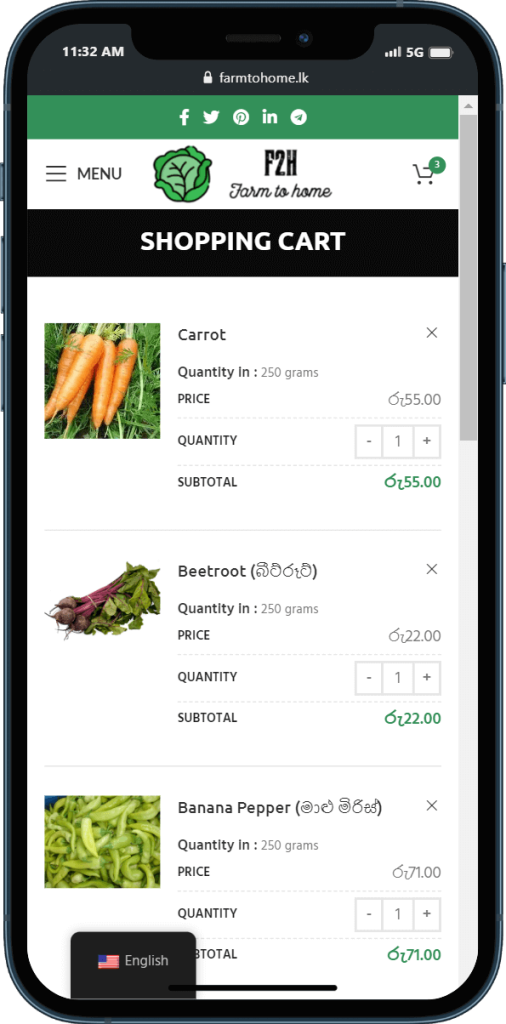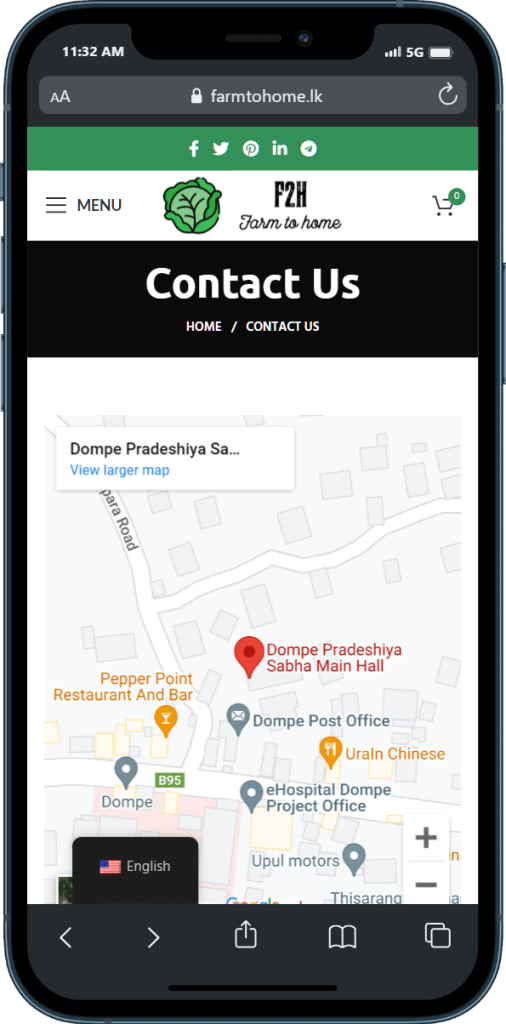Farm to Home E-Commerce website
About
Farmtohome.lk is an online platform that provides fresh vegetables and fruits directly from the farm to the customer’s doorstep in Sri Lanka¹. The website offers a wide range of products that are locally grown and harvested. Customers can benefit from the convenience of ordering fresh produce online and having it delivered to their doorstep.
Project overview
The Product
The company's state-of-the-art website, featuring cutting-edge e-commerce capabilities that empower users to effortlessly browse and place orders for our premium farm harvest from the comfort of their homes. This innovative platform is designed to provide utmost convenience and accessibility, ensuring a seamless and enjoyable shopping experience for all our valued customers.
Project Duration
6 Months
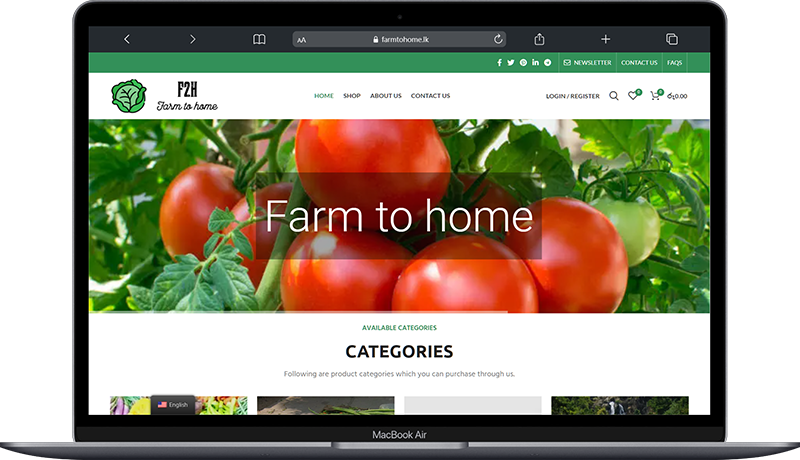
The Problem
The company "Farm to Home" faced significant challenges due to the absence of an e-commerce website. The primary problems that necessitated the creation of their e-commerce project were limited accessibility, distribution and delivery inefficiencies, constrained market reach, and the lack of customer convenience.
- Limited Accessibility: The company's traditional brick-and-mortar setup restricted their reach, preventing them from tapping into a broader customer base. With no online presence, they struggled to cater to consumers beyond their local markets. An e-commerce website became imperative to bridge this gap and make their farm produce accessible to customers from all regions of Sri Lanka.
- Distribution and Delivery Inefficiencies: Delivering perishable farm produce while ensuring maximum freshness proved to be a logistical challenge. Without an e-commerce platform, the company faced difficulties in streamlining their distribution network and efficiently delivering products to customers across the country. The lack of a centralized online system hindered their ability to optimize distribution, impacting the overall customer experience.
- Constrained Market Reach: The absence of an e-commerce website limited the company's market reach and potential for growth. Without an online platform, they struggled to expand their customer base beyond their local vicinity. To unlock new market opportunities and foster business expansion, the company needed an e-commerce solution to cater to a wider demographic of customers.
- Lack of Customer Convenience: Traditional shopping methods offered limited convenience to customers who preferred the ease of shopping from their homes. The absence of an online ordering system denied customers the flexibility to browse and place orders for farm produce with ease. By not providing a user-friendly digital interface, the company missed out on enhancing customer satisfaction and loyalty.
To overcome these pressing problems, the company recognized the urgent need for an e-commerce website. Such a platform would facilitate increased accessibility, streamline distribution and delivery processes, expand market reach, and offer customers the convenience of shopping from home. By implementing an e-commerce project, "Farm to Home" aimed to revolutionize their operations and elevate the overall shopping experience for consumers seeking farm-fresh produce online.
Project Goal / Solution
To design and develop an e-commerce website that enables “Farm to Home” to sell and deliver fresh farm produce to customers across Sri Lanka, while enhancing customer convenience, satisfaction, and loyalty.
Roles & Responsibilities
Requirement gathering
As we embark on the e-commerce project for “Farm to Home,” our first crucial step is to gather comprehensive business requirements. To achieve this, we initiated a series of meetings with key stakeholders, including the company directors, farmers, and regular customers.

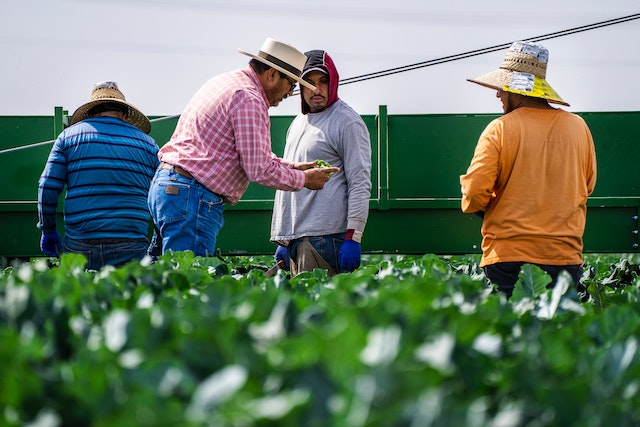
- Meetings with Company Directors:
In our initial meetings with the company directors, we aimed to understand their vision and objectives for the e-commerce project. We discussed their specific goals, such as expanding market reach, increasing sales, and improving overall customer satisfaction. By delving into their long-term business strategy, we gained insights into the desired outcomes and expectations for the e-commerce platform. Additionally, we addressed any concerns or challenges they might have regarding the implementation process, budget constraints, and timeline. - Engaging with Farmers:
Next, we met with the farmers who supply the fresh produce. Understanding their needs and constraints was crucial for designing a seamless e-commerce experience. We discussed their harvesting schedules, inventory management requirements, and transportation capabilities. By actively involving farmers in the project, we aimed to ensure that the e-commerce platform would complement their existing operations and provide them with a reliable channel to connect with customers directly. - Conducting Customer Feedback Sessions:
To better understand the preferences and expectations of regular customers, we conducted feedback sessions and surveys. These interactions allowed us to gain valuable insights into their shopping habits, preferences for product categorization, and desired features in the e-commerce platform. Understanding their pain points while shopping for farm produce enabled us to design a user-friendly interface and optimize the ordering process, ensuring a smooth and enjoyable experience for customers. - Analyzing Market Research Data:
In parallel with the stakeholder meetings, we conducted comprehensive market research to identify industry trends, competitors’ offerings, and customer behavior. This analysis provided us with valuable data to tailor the e-commerce platform to the specific needs of “Farm to Home” and its target market. By aligning the platform with market demands, we aimed to gain a competitive advantage and enhance customer engagement. - Defining Technical and Functional Requirements:
Based on the insights gathered from the company directors, farmers, and customers, we proceeded to define the technical and functional requirements of the e-commerce project. This included determining the necessary features and functionalities, such as a user-friendly interface, secure payment gateways, real-time inventory updates, efficient order processing, and seamless communication channels. The technical requirements encompassed platform scalability, security measures, and integration with existing systems.
- Meetings with Company Directors:
By actively engaging with all stakeholders, including the company directors, farmers, and regular customers, we successfully gathered comprehensive business requirements for the e-commerce project. This collaborative approach ensured that the platform would align with the company’s vision, cater to the needs of farmers and customers, and position “Farm to Home” as a leading provider of farm-fresh produce through an intuitive and customer-centric online platform.
UX Design / System Design
In the UX design process, we followed a systematic approach to create a user-centric e-commerce platform for “Farm to Home.” The steps involved conducting stakeholder meetings with company directors, farmers, and regular customers to gather business requirements, understand their needs, and identify pain points. Based on these insights and market research data, we defined technical and functional requirements for the platform, ensuring it aligned with the company’s vision and catered to customer expectations.
To visualize the user interface and layout, we employed wireframing methods, using tools like Adobe XD, to create low-fidelity representations of the platform’s design. These wireframes allowed us to explore different layout options and user flows, enabling efficient iteration and refinement of the design. By involving stakeholders in wireframe reviews, we ensured their input and feedback were incorporated into the final design.
Next, we proceeded to create high-fidelity mockups using Adobe XD, transforming the wireframes into visually polished representations of the e-commerce platform. The mockups captured the design’s visual elements, such as colors, typography, and graphics, resulting in a cohesive and visually appealing user interface. Regular feedback and revisions during the mockup phase helped us fine-tune the design to meet the brand identity and user preferences.
To demonstrate the platform’s functionalities, we developed interactive prototypes using Adobe XD. These prototypes showcased how different features and interactions would work within the platform, allowing stakeholders to experience the user journey and test the functionalities firsthand. The prototypes acted as a dynamic representation of the final product, facilitating discussions and validation of design decisions.
Throughout the UX design process, usability testing was conducted with actual users to evaluate the platform’s performance, identify usability issues, and gather feedback for further improvement. This iterative testing approach ensured that the final design met user needs and expectations, resulting in a seamless and delightful user experience.
By integrating stakeholder collaboration, wireframing, high-fidelity mockups, interactive prototyping, and usability testing, we successfully delivered a user-centric e-commerce platform for “Farm to Home.” The platform’s intuitive design, visually appealing interface, and well-tested functionalities provide customers with a convenient and enjoyable shopping experience while aligning with the company’s business goals and brand identity.


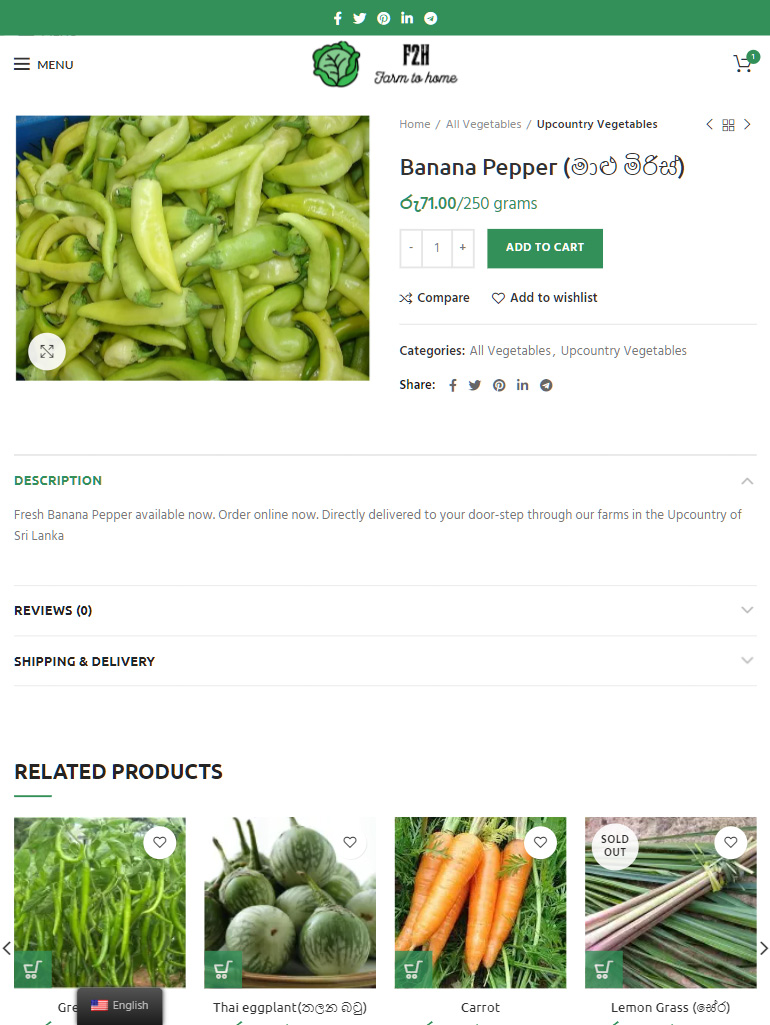
System setup and web page creation
Several content management systems (CMS) were assessed to select the suitable system for this project. WordPress CMS was selected as the suitable CMS system. It also has e commerce capabilities when used with the WooCommerce plugin.
WordPress was setup on an AWS LightSail Server.
The mockups were converted to responsive web design through creating a custom WordPress theme.
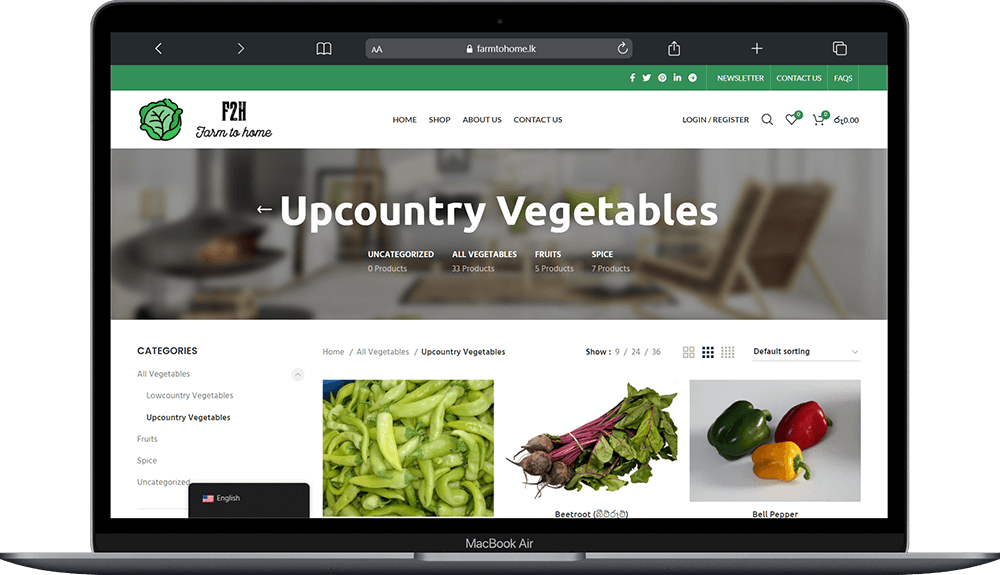
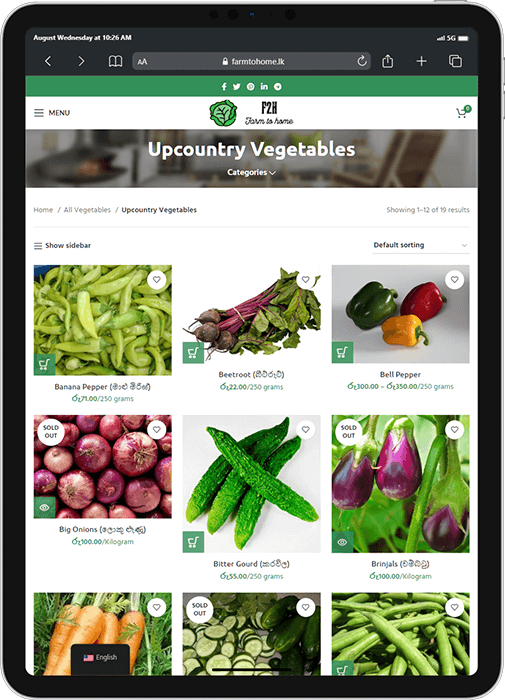
System testing
The QA Testing team carried out an initial testing of all functions including the ones tested previously at the prototypes usability testing. This time the testing was on the actual system rather than the prototypes.
Special attention was given to responsiveness of the website. The site was tested on various device sizes using tools such as Chrome dev tools. Web site performance was analyzed using Google Page Speed Insights.
5 participants other than those who tested the prototypes were chosen. 3 from the staff + 2 from the management.
The same functions which were tested during the previous usability testing was tested on the actual system. Other functions such as contact forms were also tested at this point.
Identified QA issues and solutions
- Responsive issues – The web was not loaded correctly on some devices. They were fixed using CSS Media Queries
- No search option – Search bar added
- Unit of sales – Each vegetable and fruit had a different sales unit. The system did not provide an option to define a unit of measure. This was fixed by adding the UOM field in the stock management
Implementation
The domain name was pointed to the server through a DNS setup
User training was carried out for the stock admins, and content managers
CSV file was prepared to import multiple items to the system at once.
The items were imported into the stock (E-commerce store) through the CSV
Future
- Search Engine Optimization
- Further enhancements to the responsiveness
- Further improvements to the accessibility
- More convenient ways of item entry
- API to connect mobile apps
Achievements
- Increased accessibility: The project enables “Farm to Home” to sell and deliver fresh farm produce to customers across Sri Lanka, regardless of their location. The project also allows customers to access the company’s website from any device, such as desktops, laptops, tablets, or smartphones.
- Streamlined distribution and delivery: The project helps “Farm to Home” optimize their distribution network and efficiently deliver products to customers across the country. The project also enables the company to track and monitor their inventory, orders, and shipments in real-time, ensuring maximum freshness and quality of their farm produce.
- Expanded market reach: The project allows “Farm to Home” to tap into new market opportunities and foster business expansion. The project also helps the company attract and retain more customers by offering competitive prices, discounts, promotions, and loyalty programs.
- Enhanced customer convenience: The project provides customers with the convenience of shopping from home, saving them time and money. The project also offers customers the flexibility to browse and place orders for farm produce with ease, using a user-friendly digital interface. The project also improves customer satisfaction and loyalty by providing fast and reliable delivery, secure payment options, and responsive customer service.
Lessons Learned
-Be honest about your appetite for complexity: E-commerce projects can involve many technical and business challenges, such as integrating with existing systems, managing inventory and orders, ensuring security and compliance, etc. It is important to be realistic about the scope and budget of the project, and prioritize the most essential features and functionalities. Trying to do too much at once can lead to delays, errors, and dissatisfaction.
– Figure out who owns the e-commerce project: E-commerce projects require collaboration and coordination among various stakeholders, such as developers, designers, marketers, salespeople, customers, etc. It is crucial to have a clear vision and strategy for the project, and assign roles and responsibilities to each team member. Having a dedicated project manager or leader can help ensure effective communication, alignment, and accountability.
– Start small for your first rollout: E-commerce projects can benefit from an agile and iterative approach, where the project is divided into smaller phases or sprints, and each phase is tested and validated before moving on to the next one. This can help reduce risks, improve quality, and incorporate feedback faster. Starting small can also help build trust and confidence among the stakeholders, and demonstrate the value of the project.
– Don’t save your integration for the end: E-commerce projects often depend on integrating with other systems or platforms, such as payment gateways, shipping providers, CRM tools, etc. These integrations can be complex and time-consuming, and may require customization or adaptation. It is advisable to plan and implement these integrations early in the project, rather than leaving them for the last minute. This can help avoid potential issues, delays, or conflicts that may arise later.
– Prioritize a fast path to value: E-commerce projects should aim to deliver value to the customers as soon as possible, by providing them with a convenient, satisfying, and loyal shopping experience. This means focusing on the features and functionalities that matter most to the customers, such as free shipping, easy returns, user-friendly interface, competitive prices, etc. These features can help increase conversions, retention, and referrals, and ultimately boost sales and revenue.
